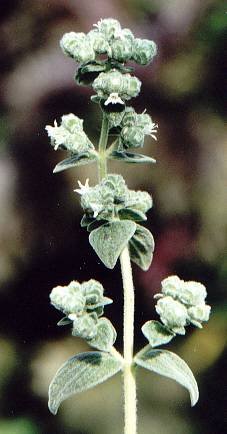|
|||||
|
|||||||
|
    An initiative of :Stichting Food-Info
|
| Food-Info.net> Food Products > Spices Marjoram (Maiorana hortensis)Plant familyLamiaceae (mint family) Botanical synonymsOriganum maiorana OriginMarjoram stems from Asia Minor. Since it is a popular spice, it is cultivated not only in Mediterranean countries, but also in Central and Eastern Europe, although best qualities require a fairly hot climate . Used plant partLeaves Sensoric qualityAromatic and slightly bitter. There is not much olfactory resemblance to the botanically related oregano. Main constituentsThe content of essential oil depends on soil, climate and season, but generally lies between 0.7% and 3.5%. The main aroma component is a bicyclic monoterpene alcohol, cis-sabinene hydrate (max. 40%); furthermore, a-terpinene, 4-terpineol, a-terpineol, terpinenyl-4-acetate and 1,8-cineol are found in significant amounts. Phenolic compounds, which make up for the typical fragrance of the closely related oregano, are missing altogether.
 Marjoram, flowering plant UseMarjoram, similar to tarragon (botanically not related), is a spice which on one hand needs a warm climate to develop its specific aroma, but on the other hand loses some fragrance when dried. Despite these deficiencies, it is a well-established culinary herb in Central Europe. Dried marjoram is extremely important in industrial food processing and is much used, together with thyme, in spice mixtures for the production of sausages; in Germany, where a great variety of sausages is produced, it is thus called Wurstkraut sausage herb. Furthermore, application of marjoram to boiled or fried liver is somewhat classical. Marjoram may be effectively combined with bay leaves; furthermore, it goes well with small amounts of black pepper or juniper. Combinations of the last type are well suited to ragouts, particularly venison. Yet marjoram also has its place in vegetable dishes; it is mostly recommended for rather heavy vegetables like legumes or cabbage. Fried potatoes spiced with liberal amounts of marjoram are delicious. Fresh marjoram, on the other side, is more popular in South European cooking styles. Because of its lesser fragrance in cold climate, its usage in other regions may end in serious disappointment. Fresh marjoram may add new accents to the French fines herbes and is frequently suggested for delicate fish dishes; it should be added shortly before serving. The marjoram grown in Western Asia is much more aromatic than the European variety; its flavour ranges between European marjoram and oregano. The term zahtar (also spelt zaatar or za'tar) may refer either to the spice mixture or to this powerful herb alone. Marjoram is also popular further North, around the Causasus mountains. Khmeli-suneli is used for various Georgian meat and vegetable stews and also for the many sauces Georgian cuisine is so famous for. Source : www-ang.kfunigraz.ac.at/~katzer/engl/spice_welcome.html |
|
| ||
| Food-Info.net is an initiative of Stichting Food-Info, The Netherlands | ||||||